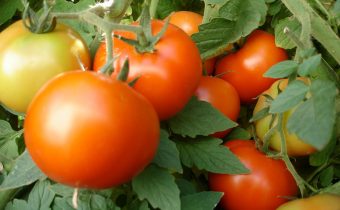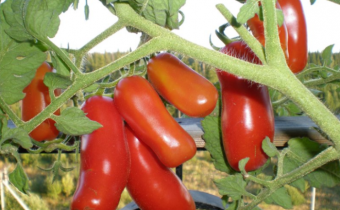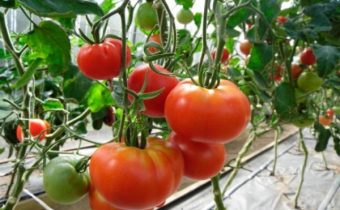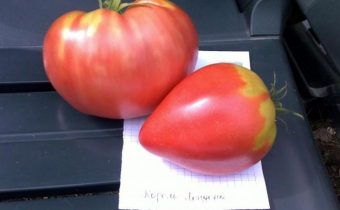When and how to feed tomatoes after planting in the greenhouse?
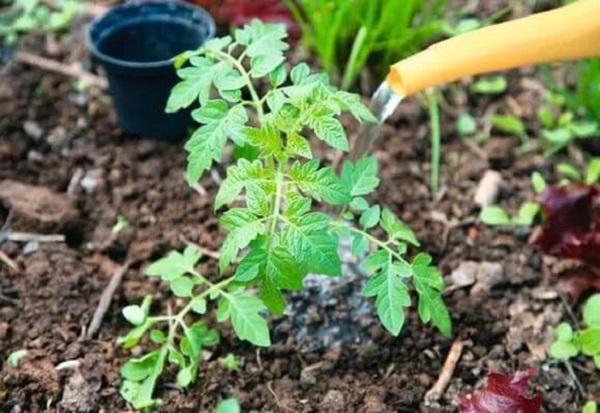
Tomato - a vegetable so popular that it is grown not only in the beds, but even on the balconies and window sills. Still, the most stable is the yield obtained in greenhouses and greenhouses. How to feed tomatoes when you need to do it, what means to use and a lot of other useful information on growing your favorite vegetable you will learn from the article.
Than to feed tomatoes to be plump
A healthy tomato has a thick, powerful stem, leaves of a rich green color. And this is literally from the appearance of seedlings until the very end of fruiting. If deviations from the norm occur, it means that the rules of cultivation were not observed and measures must be taken urgently so as not to be left without a crop.
Tomatoes love fertile, loose soil, stable temperature, moderate air and soil humidity, as well as sufficient light. If you follow all these rules, you already have 70% confidence in obtaining a generous crop of tomatoes. But if there is not enough and timely feeding, then all efforts may be in vain. Only through the introduction of nutrients into the soil and carrying out foliar fertilization of plants, can we expect a good result.
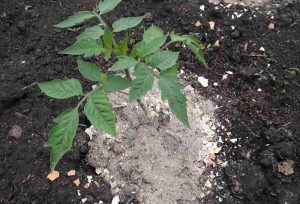
The most common problem with tomato soreness is nitrogen deficiency. At the same time, the shoots are excessively stretched and become weak.
If the leaves begin to acquire a purple hue, this may be a sign of a lack of phosphorus. Potassium deficiency contributes to the development of top rotso try not to let the seedlings starve.
To feed the tomatoes in the greenhouse should not be when they let know about it. In this case, it is time to take emergency measures, and fertilizer should be made on a specific schedule. Consider it next.
Feed chart and how often to feed
For convenience, not only for beginners, but also experienced gardeners will not hurt to have a mini-calendar. This can be a regular notebook or notebook. Here it will be necessary to paint the order of the fertilizing, and then mark the date of their holding and make other marks for your convenience.
Schedule feeding developed by experienced breeders, so do not even doubt its effectiveness.
The first feeding is carried out when the first leaf appears on the shoot. For this purpose, complex store mineral preparations are used, which can be selected with the help of sales assistants. It is possible that you will recommend Nitrophoska or Agricola. They must be dissolved according to the instructions, but most often it is a teaspoon per liter of water. This volume is enough for additional feeding of forty young sprouts. After the procedure, they will begin to grow right before our eyes.
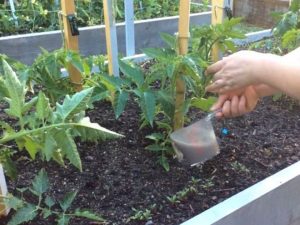
The second time irrigated with fertilizer is carried out after 10 days. Most varieties, even if all the recommendations on cultivation are observed, are drawn out by this time, therefore, growth inhibitors are used for top dressing. This may be Effecton or Athlete. These funds are diluted in the proportions table. spoon per liter of water. You can also use superphosphate - 1 table.l. three liters of water. At this stage, the use of folk remedies is already permitted. Considered the most appropriate chicken droppings.There is a lot of nitrogen in it, but it won't hurt young sprouts. Dilute it with water 1: 2, insist 4-5 days, and before carrying out dressing, dilute the liter of the prepared infusion in ten liters of water.
The third dressing is carried out in a week. It uses nitrophosphate solution (table-spoon per 10 liters of water).
After ten days, the seedlings must be fed with superphosphate or potassium sulfate (spoon per 10 liters). Pour the soil very abundantly. This procedure is aimed at strengthening the root system and improving the immunity of the plant.
After another ten days, a solution of nitrophobia is applied again (spoon per 10 liters of water). By this time, the seedlings are already large, so you need to pour at least a glass of fertilizer under each bush.
The sixth stage is carried out in 7-10 days and consists in carrying out both root and foliar dressing. And again comes to the aid nitrofoska. First, it is watered every bush (a glass), and then they spray the leaves with the same solution.
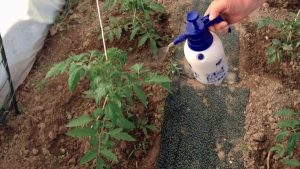
If the leaves are weak, you can use additional fertilizer ready-made mineral fertilizers, such as "Bud for tomatoes." In parallel, the bushes are fed with a solution of urea (a matchbox on a bucket of water).
It is possible to fertilize not only with store preparations, many people choose folk remedies not only for their availability, but also for an excellent result.
Folk remedies
The most common means for feeding tomatoes are iodine, shivering, nettle, wood ash, droppings, compost, etc. It should be understood that improvised preparations should also be used strictly according to the instructions and safety precautions must be observed when processing plants.
Yeast
About the use of yeast as a growth stimulator, I didn’t hear that the person who has no garden work at all. But it's not about accelerating growth. There are live microorganisms in yeast, which, getting into the soil, effectively destroy pathogenic fungi, make the soil more friable, saturate it with proteins, amino acids, iron, various microelements.
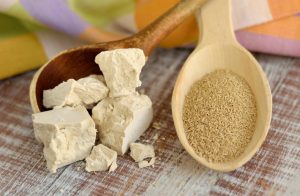
You can use both raw (pressed) and dry yeast. Proportions are taken as for a dough for a test. Yeast pour a small amount of warm water and add sugar. We leave for several hours, and before carrying out feeding we dissolve at the rate of a liter per bucket of water. Water under an adult plant in 500 ml.
Fine effect gives yeast dressing, cooked with freshly cut grass. Hops are especially good for this purpose. Fill the large barrel with a third with grass, top up with water and literally add a spoonful of yeast. After three days from the start of the fermentation, the fertilizer will be ready. Water half a liter as an adult bush.
You can cook "live" fertilizer without yeast. To do this, fill the three-liter jar with one-third with black bread, add water and put in a warm place for fermentation (about 3-5 days). Before use, dilute with water in proportions of 1:10.
You can use yeast dressing no more than 2 times a month, and it is better to alternate it with other types of dressings.
Wood ash
Ash can be used to feed tomatoes and many other plants at any stage of their growth and development.

The first time it is allowed to make it into the wells prepared for sowing seeds. In this case, it acts not only as a source of nitrogen and many other useful trace elements, but also in order to make the soil looser and sanitize it. Only you can not make ash immediately before planting. So the seeds can get burned.
In the future, with the help of ash, root and foliar feeding is carried out. The saturation of the solution depends on the available target. For irrigation dissolve a liter of ash in 10 liters of water. For the treatment of pests and diseases, a pasty mixture is prepared and the leaves are greased with it.This is a very effective tool that helps to save even a seriously ill plant.
Iodine
Watering iodine solution of tomatoes gives excellent results, especially when growing them in a greenhouse. Feeding is carried out no more than 2-3 times during the entire growing season.
The first time its strength can be used when there are 2 true leaves on the sprout. At this age, seedlings can be watered with a solution of 1 drop of iodine and 3 liters of water. Top dressing will make the stems more powerful, and the leaves juicy.
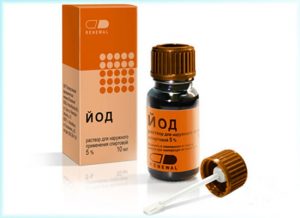
The second time is watering during the formation of ovaries. This time, three drops of iodine are added to ten liters of water. Under each bush 300-500 ml of solution are applied, depending on the variety (for tall ones more).
The third dressing with iodine is carried out during the period of active fruiting, when about a third of the fruits have already been harvested from the bushes. This time the action can be enhanced by adding to the solution of 3 drops of iodine and 10 liters of water a liter of wood ash. If you use this recipe, first dissolve the ashes in the water and let it stand for a while, and just before the irrigation add iodine.
One of the methods of protection against fusarium is a solution that is also prepared on the basis of iodine. Only dissolve it not in water, but in serum. Three drops of iodine are added to three liters of dairy product (homemade, not in-store), and then this mixture is dissolved in ten liters of water and tomatoes are carefully sprayed.
Nettle
Weeds, to which gardeners also include nettles, have long been successfully used for the preparation of "slurry". So called fertilizer from freshly cut grass. It is prepared easy. The grass is folded into the barrel and filled with water as soon as it starts to ferment - ready, you can use it for watering. The smell is like that of fresh manure, but the result from feeding is no worse. If the tomatoes are young, it is better to pour the solution in between the rows, and adult plants can be watered and under the root.
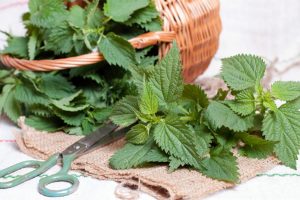
Nettle is used not only for the preparation of slurry. It is laid out between the holes, used for mulching and even specially planted in greenhouses, in order not only to provide the cultivated crop with protection against pests, but also to enrich the soil with useful trace elements, to make it more friable.
Chicken droppings
Chicken dung is a universal fertilizer that gives excellent results, including for tomatoes. One of the ways to use it is to deposit it into the ground during the digging of the beds from autumn. But it is also used for the preparation of solutions and watering. To do this, he is divorced in proportions of 1: 100, if fresh, and 1:50, if he lay down for at least a year.
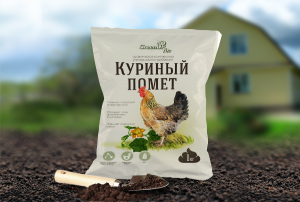
The peculiarity of chicken manure is that it will never be much, which means that the plants will not be harmed by it. Use clean litter, and this is only for those who keep chickens in cages. If the birds lead a free lifestyle, it is even better. Regular cleaning of the shed will provide the gardener with a sufficient amount of fertilizer, and tomatoes - an endless way of feeding.
To do this, the collected litter mixed with the ground and the remnants of grass (not only large), just scattered along the beds. During irrigation with ordinary water, nutrients will gradually be absorbed into the soil, and tomatoes will grow to everyone surprisingly and envy.
Compost
The use of rotted waste for fertilizer has been known to gardeners for many years. And for tomatoes, especially in the greenhouse, it is indispensable. The fact is that with the help of compost it becomes possible to update the soil. Manure for closed beds is also used, but it is necessary to buy it, and then wait a certain time too.Compost can also be made in the fall and spring, when digging before planting. It is perfectly loosening, saturates the soil with useful trace elements.
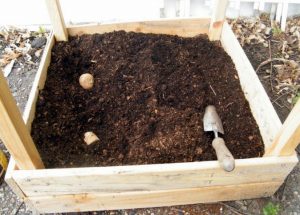
Also for cultivated tomatoes in greenhouses the following folk remedies are used as a top dressing:
- 4-5 eggshells dry, ground into powder, pour water and insist week. Before watering, dissolve in half with water;
- one banana peel pour a liter of water, insist week, strain, mix with 10 liters of water and pour;
- sleeping coffee grounds are mixed with soil before planting tomatoes, or poured into grooves dug around an adult plant;
- 20 grams of onion peel pour 3 liters of water, insist week, strain, use for spraying.
And the tomatoes themselves are excellent for themselves and other plants feeding. During the removal of the stepsons, do not throw them away, prepare an infusion and spray the plants and walls of the greenhouse. This will help get rid of any insects, as well as feed the power of plants.
Not all people use folk remedies, many opt for store drugs. Consider the most effective and popular ones.
Mineral fertilizers
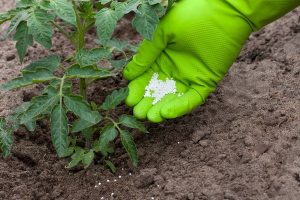
Having correctly picked up the ready mix, you can provide your tomatoes with all the substances necessary for full growth and development. Do not rush to buy bags with bright names and an attractive price. Try to choose proven drugs for years.
One of these is Vermicofe (the name may vary slightly depending on the manufacturer). It is used at the stage of growing seedlings. It contains a huge amount of vitamins, acids, phytohormones, as well as nitrogen, phosphorus and potassium. The drug is absolutely natural, so you can use it safely for the next harvest.
The use of vermicofeys stimulates the normal development of tomatoes, has a positive effect on photosynthesis, increases the yield and improves the quality characteristics of the fruit.
Another popular drug among gardeners is Azofoska (Nitroammofoska). It contains many nutrients, and it can be used throughout the growing period. The use of such top dressing makes tomatoes strong, resilient, positively affects the taste of fruits and their appearance. If you apply Azofoska before flowering, it will be more abundant and will give more ovaries.
Nitrophoska, perhaps, one of the most popular means for growing tomatoes. Prepared solutions based on it are used, starting from the appearance of the first true leaflet until the very end of the fruiting period.
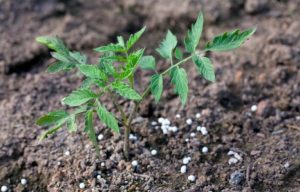
By the way, in August, when the yield of tomatoes goes into decline, and weather conditions cause the development of fungus, rot and other problems, it is Nitrophoska that comes to the aid of gardeners. She watered planting, and then spend mulching straw.
Fertika Crystal - one of the new products among this type of product, but almost all breeders claim that it is the most optimal preparation for complex feeding of tomatoes. In addition to nitrogen, it contains magnesium, potassium, iron, sulfur and many other components. Moreover, it is important not only the content, but also the observance of proportions, and in this case it is optimal for tomatoes.
A high content of healthy components for tomatoes is characterized by Health. At the same time it does not contain chlorine at all, and therefore it can be considered absolutely harmless. Top-dressing with this drug improves the quality of fruits, makes them more dense, tasty, resilient. It is used for root and for foliar feeding.
Another drug with a natural composition - Immunocytophyte. It is not always used, but only when the growth of the bush slows down. It is a stimulant that will also protect tomato beds from pests and diseases.
To make tomatoes more sweet and fleshy, to have more ovaries, and to fully ripen the fruit, it is recommended to feed with boron. This procedure gives a greater effect when spraying. When root feeding boron digests longer. It is enough to carry out one treatment during the flowering period of tomatoes. No need to repeat.
Do not be alarmed by the abundance of information. Growing tomatoes in the greenhouse is not so difficult, just make a calendar feeding, and assume that half the work is done.
Reviews
Katerina Stepanovna
For many years in a row I have been using fresh-cut grass for tomatoes. In the barrel box is not everything, but only the "garlic", which animals love, and nettles. Wander without yeast. Just put in a sunny place and everything. Begin to use as soon as there is a specific smell. A liter can is diluted in a bucket of water and watered, as usual, once a week. The result is verified. Tomatoes are strong, do not get sick, ripen well.
Tatyana
I use only Nitrophoska for feeding my tomatoes. I'm happy. She is worth a penny, and absolutely not harmful, and the result is excellent. Why many ways, if there is one proven tool?
Semyon Stepanovich
The greenhouse in our plot is capital, so the soil, you want, you do not want, but is depleted, as it does not feed. Last year, he removed the top layer, about 10 cm, cleaned it on open beds, and laid out the compost from above and covered it with falling foliage of fruit trees. The greenhouse for the winter was closed and everything went upside down. A couple of times more snow threw her. In the spring, two weeks before planting, everything properly loosened and that's it. If you do not know what you used for this, you might think that the new black soil delivered.
Grow tomatoes in greenhouses, based on our recommendations, and the harvest will always be generous, and the fruits are delicious!


